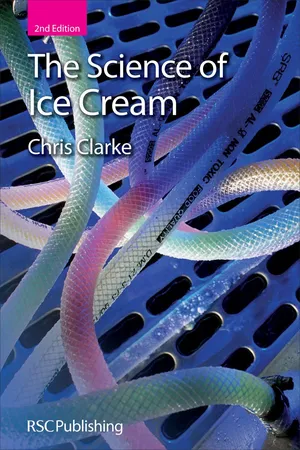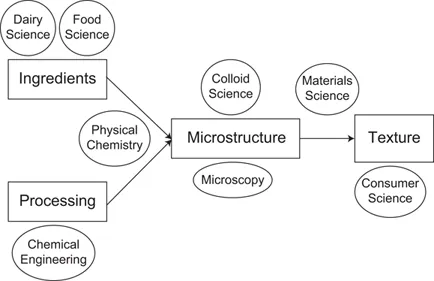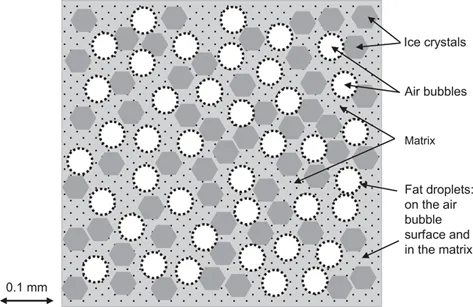![]()
CHAPTER 1
The Story of Ice Cream
1.1 WHAT IS ICE CREAM?
Ice cream is an enormously popular food. The term “ice cream” in its broadest sense covers a wide range of different types of frozen dessert. The main ones are:
- Dairy ice cream – a frozen, aerated mixture of dairy ingredients, sugars and flavours.
- Non-dairy ice cream – made with milk protein or other proteins and vegetable fat.
- Gelato – an Italian-style custard-based ice cream which contains egg yolks.
- Frozen yoghurt – which may contain lactic acid organisms, or simply yoghurt flavour.
- Milk ice – similar to ice cream, but unaerated and containing less dairy fat.
- Sorbet – fruit-based, aerated, sugar syrup which contains neither fat nor milk.
- Sherbet – similar to a sorbet, but containing some milk or cream.
- Water ice – frozen sugar syrup with flavour and colour, such as an “ice lolly”.
- Fruit ice – similar to water ice, but made with real fruit juice.
What these all have in common is that they are sweetened, flavoured, contain ice and, unlike any other frozen food, are normally eaten in the frozen state.
The legal definition of ice cream varies from country to country. In the UK “ice cream” is defined as a frozen food product containing a minimum of 5% fat and 2.5% milk protein, which is obtained by heat-treating and subsequently freezing an emulsion of fat, milk solids and sugar (or sweetener), with or without other substances. “Dairy ice cream” must in addition contain no fat other than milk fat, with the exception of fat that is present in another ingredient, for example egg, flavouring, or emulsifier.1 In the USA, ice cream must contain at least 10% milk fat and 20% total milk solids, and must weigh a minimum of 0.54 kg per litre.2
Ice cream is often categorized as premium, standard or economy. Premium ice cream is generally made from the best quality ingredients and has a relatively high amount of dairy fat and a low amount of air (hence it is relatively expensive), whereas economy ice cream is made from cheaper ingredients (e.g. vegetable fat) and contains more air. However, these terms have no legal standing within the UK market, and one manufacturer’s economy ice cream may be similar to a standard ice cream from another.
Most people are very familiar with the appearance, taste and texture of ice cream and there are many recipes for making it in cookery books. However, few people know why certain ingredients and a time-consuming preparation process are required. The answer is that ice cream is an extremely complex, intricate and delicate substance. In fact, it has been called “just about the most complex food colloid of all”.3 The science of ice cream consists of understanding its ingredients, processing, microstructure and texture, and, crucially, the links between them. This requires a whole range of scientific disciplines, including physical chemistry, food science, colloid science, chemical engineering, microscopy, materials science and consumer science, shown in Figure 1.1.
Figure 1.1 The sciences of ice cream.
The ingredients and processing create the microstructure which is shown schematically in Figure 1.2. It consists of ice crystals, air bubbles and fat droplets in the size range from 1 μm to 0.1 mm and a viscous solution of sugars, polysaccharides and milk proteins, known as the matrix. The texture we perceive when we eat ice cream is the sensory manifestation of the microstructure. Thus microstructure is at the heart of the science of ice cream, and forms the central theme running through this book.
Figure 1.2 Schematic diagram of the microstructure of ice cream.
In order to describe the science of ice cream, it is first necessary to describe some of the physical chemistry and colloid science that underpins it; these are laid out in Chapter 2. Chapters 3 and 4 cover the ingredients and the ice cream making process respectively. Chapter 5 focuses on the production of various types of ice cream product. The physical and sensory measurements used to quantify and describe it are discussed in Chapter 6, and the microstructure, as well as its relationship to the texture, is examined in Chapter 7. Finally, Chapter 8 describes a number of experiments that illustrate the science of ice cream which may be performed in the laboratory, classroom or kitchen. We begin, however, by looking at where and when ice cream was invented, and how it has evolved into the huge range of products eaten by billions of people all around the world today.
1.2 THE HISTORY OF ICE CREAM
Ice cream as we recognize it today has been in existence for at least 300 years, although its origins probably go much further back in time. The history of ice cream is full of myths and stories, which have little real evidence to support them. A typical “history” begins with the Roman Emperor Nero (AD 37–68) who is said to have eaten fruit chilled with snow brought down from the mountains by slaves. Elsewhere, Mongolian horsemen are reputed to have invented ice cream. They took cream in containers made from animal intestines as provisions on long journeys across the Gobi desert in winter. As they galloped, the cream was vigorously shaken, while the sub-zero temperature caused it to freeze simultaneously. The expansion of the Mongol empire spread this idea through China, from where Marco Polo reputedly brought the idea to Italy when he returned from his travels in 1295. It has been claimed that ice cream was introduced to France from Italy when the 14-year-old Catherine de Medici was married to the Duc d’Orléans (later Henri II of France) in 1533. Her entourage included Italian chefs who brought the recipe for ice cream with them. The secret of making ice cream remained known to only a few. So precious was it that Charles I of England is said to have offered his French chef a pension of £500 per year to keep his recipe secret.
However, historical research has found little factual evidence to support any of these stories. The only mention of ice in connection with Nero comes from Pliny the Elder in the first century AD, who records the discovery that water which has been boiled freezes faster and is healthier. There is no mention of ice cream in any of the manuscripts describing Marco Polo’s travels. Indeed, modern historians doubt that he even reached China. It is unlikely that Catherine’s chefs knew how to make ice cream since, at that time, the method of refrigeration by mixing ice and salt was known in Europe only to a handful of scientists. Nor is there any documentary evidence for Charles’ chef.
We cannot be absolutely sure of exactly who invented ice cream, or where and when. In reality, the history of ice cream is closely associated with the development of refrigeration techniques and can be traced in several stages coupled with these:
- Cooling food and drink by mixing it with snow or ice.
- The discovery that dissolving salts in water produces cooling.
- The discovery (and spread of the knowledge) that mixing salts and snow or ice cools it even further.
- The invention of the ice cream maker in the mid-19th century.
- The development of mechanical refrigeration in the late 19th and early 20th centuries.
Concurrent with these a vast range of recipes has been developed, spanning the spectrum from chilled fruit juices to what we understand as ice cream today. The evolution of ice cream has been described in detail in the two excellent histories listed under Further Reading (Section 1.6) and the following summary owes much to their researches.
Ice has been used to chill food and drink for at least 4000 years in many different parts of the world. Ice cellars dating back to 2000 BC have been discovered in Mesopotamia (present-day Iraq). Records from the Zhou dynasty in China ca. the 11th century BC describe the role of the court iceman, who had a large staff responsible for harvesting ice every winter and storing it in cellars to be served with drinks in the summer. An ice-cooled dessert, made from water buffaloes’ milk mixed with flour and camphor is recorded in the Tang dynasty (AD 618–907). In Greece, drinks were served with snow in about 500 BC and a Roman cookery book dating from the 1st century AD includes recipes for sweet desserts that are sprinkled with snow before serving. Sweet drinks cooled with ice are recorded in Persia in the 2nd century AD. Rather than harvesting ice during the winter, the Persians exploited the cold desert nights to freeze water that had been placed in shallow pits.
The first significant step forward was the discovery that water is cooled when salts are dissolved in it, such as common salt (sodium chloride), saltpetre (potassium nitrate), sal-ammoniac (ammonium chloride) or alum (a mixture of aluminium sulphate and potassium sulphate). When the crystals dissolve, the strong bonds between the ions are broken, extracting heat from the surrounding water, so the temperature drops. Adding a mixture of 5 parts ammonium chloride and 5 parts potassium nitrate to 16 parts water at 10°C causes the temperature of the mixture to drop to about −12°C, sufficient to freeze a vessel of pure water immersed in it. This phenomenon is first recorded in an Indian poem from the 4th century AD, and described in detail in an Arabic medical textbook from 1242. Another book in Arabic containing sorbet recipes appeared at about the same time.
These methods were known in the West by the early 16th century. Soon thereafter, in 1589, Giambattista Della Porta, a scientist from Naples, made the breakthrough that paved the way for making ice cream as we know it today. He reported the discovery, possibly based on Arabic knowledge of cooling techniques, that much greater cooling could be achieved by mixing ice and salt. (This effect is explained in Chapter 2.) Della Porta used this discovery to freeze wine in a glass placed in a mixture of ice and salt. Others became aware of the phenomenon, and the first reports of iced desserts produced using this method of freezing began to appear in the 1620s. These appear to have been water ices, rather than ice cream. Water ices were served at banquets in Paris, Naples, Florence and Spain during the 1660s.
The earliest evidence for ice cream in England comes from a list of the food that was served at the feast of St George at Windsor in May 1671; ice cream was served, but only at King Charles II’s table. Techniques and recipes then developed, notably in France. In 1674 Nicholas Lemery published a recipe for water ice and two years later Pierre Barra described freezing a mixture of fruit, cream and sugar by using snow and saltpetre. L. Audiger noted the importance of whipping the mixture during freezing to break up large ice crystals in 1692. This technique still forms the basis of ice cream making today.
More recipe books appeared in the 18th century that helped to widen knowledge of how to make water ices and ice creams which became a luxury served by the aristocracy at banquets. This was accompanied by the production of special moulds, ice pails (for keeping ices cold) and serving cups. The extent of the spread of ice cream can be seen by the orders for the utensils associated with its production and serving. Those who are recorded as having such services include Louis XV of France, Gustaf III of Sweden and Catherine the Great of Russia. Ice cream remained the preserve of royalty and aristocracy in Europe, and of high-ranking officials in the USA, where in 1744 the governor of Maryland is one of the first people recorded to have served it. A presidential connection with ice cream began with George Washington, who often served it at official functions, as did the third president, Thomas Jefferson. After his time as American envoy in France, Jefferson brought back an ice cream recipe from his French chef. Ice cream was served at the inaugural dinner for the fourth president, James Madison, and subsequently became a regular feature of the White House menu.
By the beginning of the 19th century, ice cream had started to move from the tables of the aristocracy into restaurants and cafes that served the well-off middle classes. This was accompanied by an increasing interest in good food, reflected in the appearance of many books on cooking. Ice cream was made by hand, by placing a bowl containing ice cream mix in a barrel filled with ice and salt, and using a scraper to remove growing ice crystals from the sides of the bowl until in the 1840s Nancy Johnson of Philadelphia invented the first ice cream making machine. Her invention comprised two spatulas that fitted tightly into a long cylindrical barrel. The spatulas contained holes and were attached to a shaft that could be rotated with a crank. The outside of the cylinder was cooled with a mixture of salt and ice. The holes made it easier to rotate the spatulas in the mix and simultaneously scrape ice crystals off the inner wall of the cylinder. This invention simplified ice cream production and ensured a more uniform texture than had previously been possible. At about the same time, people in Europe were coming up with other ideas for ice cream making machines and a large number of patents were published both in Europe and the USA in the following decades. Mechanization meant that ice cream could be produced more cheaply and in much larger volumes. Jacob Fussell, a dairy farmer from Baltimore, USA, is commonly considered to be the founder of the modern ice cream industry. Faced with a surplus of milk during the summer, he decided to sell it as ice cream. He built the first ice cream factory in 1851, and subsequently expanded to Washington, Boston and New York, where he sold ice cream at a price which ordinary people could afford.
In England, ice cream became available to the masses towards the end of the 19th century. This was due in part to the emigration of Italians, many of whom became ice cream vendors in cities around the world. Of the approximately ten thousand Italians living in England and Wales in at the time of the 1890 census, just under one thousand listed their occupation as street vendors, most of whom sold ice cream. They sold it in small, thick-walled glasses, known as “penny-licks”. These were usually wiped with a cloth and re-used, and were thus a considerable health hazard, particularly for children. The street vendors would drum up business by calling out “ecco un poco”, Italian for “here is a little”. The words “ecco un poco” became “hokey pokey”, now meaning either poor quality ice cream, or deception/trickery.4 Poor hygiene standards necessitated the introduction of regulations around the turn of the century.
One person who was not impressed with the quality of street-sold ice cream was Agnes Marshall (1855–1905). She was a celebrity cook with an interest in new technology. As well as inventing an ice cream maker (Figure 1.3), she wrote several books, including two dedicated to ice cream. She toured extensively, lecturing and demonstrating her techniques to large audiences and campaigned for better standards of food hygiene. She can also claim to have invented the ice cream cone in 1888, since a recipe for “cornets with cream” appears in one of her books. However, the cone really took off at the 1904 St Louis World’s Fair, when a stall selling ice cream ran out of dishes in which to serve it. Ernest A. Hamwi, a waffle vendor in the next-door stall, had the bright idea of rolling up his waffles as cones instead. There were tens of thousands of visitors at the Fair, so the idea then spread rapidly throughout the USA.
Figure 1.3 Mrs Marshall’s ice cream maker (courtesy of the London Canal Museum, www.canalmuseum.org.uk).
Ice cream making required a source of ice. Starting in the first half of the 19th century, ice was collected from rivers and lakes in Norway, Sweden, Canada and the northern USA and then shipped to cities in Europe, the USA and even as far away as Calcutta! However, physicists and engineers were developing techniques for artificial refrigeration based on the liquefaction of gases such as propane and ammonia. The gas is compressed until it liquefies, during which process it heats up. It i...



